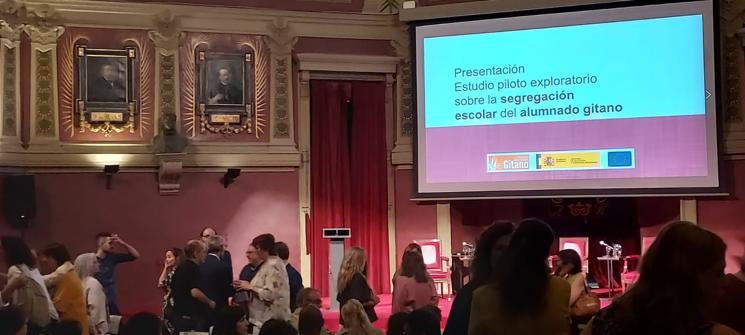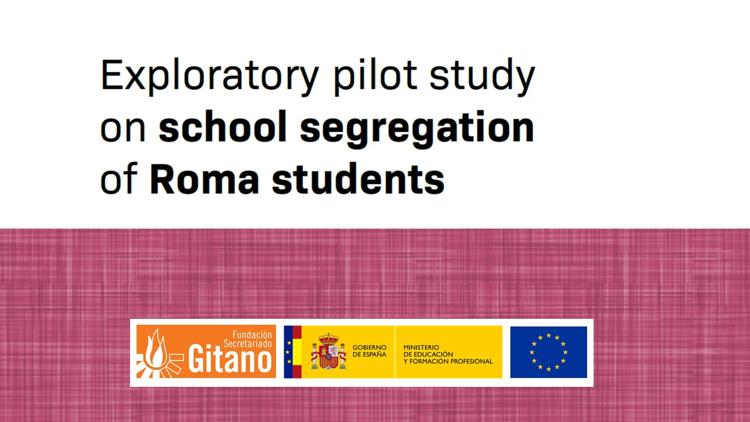19/09/2022
FSG

Fundación Secretariado Gitano (FSG), in collaboration with the Spanish Ministry of Education and Vocational Training, has presented this morning, in Madrid, the results of the Exploratory pilot study on school segregation of Roma students which reviews the school segregation of Roma students in six Spanish cities: Alicante, Almería, Barcelona, Madrid, Seville and Valladolid.
This Advocacy Conference and National Training was part of the European project "NO Segregation Local Action Against School Segregation of Roma", one of the pioneering research on school segregation of Roma students. This project, funded by the European Commission and coordinated by the Bulgarian NGO Amalipe, provided data on the state of school segregation of Roma children in Spain, Bulgaria and Belgium.
Isidro Rodriguez, FSG Director General, and Purificación Llaquet, Deputy Director General for Evaluation and Territorial Cooperation at the Ministry of Education, were in charge of opening the event. Representatives of FSG Education Department then presented the results of the Study. This was followed by a training for municipal authorities, educators and NGOs present in the room. This activity was divided into two working roundtables: the first one featured reactions to the Study by representatives of Spanish and European public administrations; the second one gathered experts and representatives of civil society. The closing remarks were delivered by Mónica Domínguez, Director General for Evaluation and Territorial Cooperation at the Ministry of Education, and Sara Giménez, FSG President.
The Study performs a quantitative analysis of the phenomenon of school segregation faced by Roma students, with the aim of drawing attention to a specific reality that clearly shows the inequality affecting Roma students and, as a result, of promoting the adoption of adapted measures and initiatives to revert and prevent the processes of school segregation.
Up until now, the knowledge relating to the school segregation of Roma students is really limited: having data is crucial to understand a hidden reality and to promote measures that address it effectively. This study seeks to contribute to shed light on this reality, identifying some patterns regarding the possible dimension of school segregation of Roma students and the factors that are affecting the school pathways of some of these students.
School segregation infringes the right to education as well as legislation in force, affects negatively the educational performance and quality and has a clear impact on the school failure of boys and girls. And in the specific case of Roma children, it significantly reduces their opportunities for social progress and advancement.
Given the complexity of addressing school segregation, this issue has only been included as an area of interest in the political agenda over the past years. The new Spanish Education Law (LOMLOE), which came into force in January 2021, includes specific measures both to revert and to prevent the concentration of students in a situation of vulnerability. To this end, it features measures relating to the admission in education centres, including admissions criteria, with the aim of achieving a balance in the scoring systems and preventing their use to restrict access by some centres. In addition, it specifies that there should be an equal application of the admission rules both in public and in ‘concertados’ centres (privately-owned centres which receive an educational subsidy from the public authorities).
Some Spanish Regions are also starting to legislate in this sense, whether through the regulation of the admissions in educational centres and/or through programmes leading to support the segregated centres.
Results of the Study
The Study has been carried out based on a sample of 138 educational centres where 6,563 Roma children study, out of a total of 75,804.
According to the data analysed, five in ten Roma students in the sample attend segregated centres and four in ten attend severely or extremely segregated centres.
Ethnic origin is a factor which shapes and aggravates poor socioeconomic conditions. This finding coincides with what has been found by a number of writers who affirm the existence of a specific ethnic segregation, linked to other types of segregation such as socioeconomic segregation, which finds a social expression with a harmful impact on the most vulnerable people.
The tendency to overestimate the number of Roma students in classrooms is another pattern highlighted by the Study. Many schools with levels of segregation below 30% believe that the number of Roma students is high, probably owing to the inadequate training they have received to inform their teaching of these students.
The Study also shows that Roma students have very short school careers if they attend segregated centres, tending to drop out in the second year of compulsory education in secondary schools. However, they are more likely to go on to post-compulsory education if they attend non-segregated centres.
The scope for families to make decisions regarding their choice of centre when pupils have attended a segregated primary school is less than if they had attended a non-segregated primary, or one with a low concentration. According to the Study, this supports the idea that having a large scope for choice does not always mean that assignation to centres is equitable. The families with the least social and financial capital tend to be those who more often choose centres close to where they live, among other factors.
In general terms, it seems that the implementation of innovative projects/measures to combat segregation has not translated into a greater ability to attract students of other profiles to these centres to generate greater diversity, although there are some models of success at an individual level.
The lack of a legislative response and the composition effect (i.e. the effect of school composition on student performance), along with the “flight” from these schools of other social groups with greater purchasing power (white flight) are some of the factors which have been extensively studied. These factors could explain the difficulty encountered in attempting to reverse the situation of segregated centres, despite the implementation of innovative methodologies and even of some ad hoc regulatory measures, as seen for example in the regions of Castile and León, Catalonia and Valencia.

Related documents